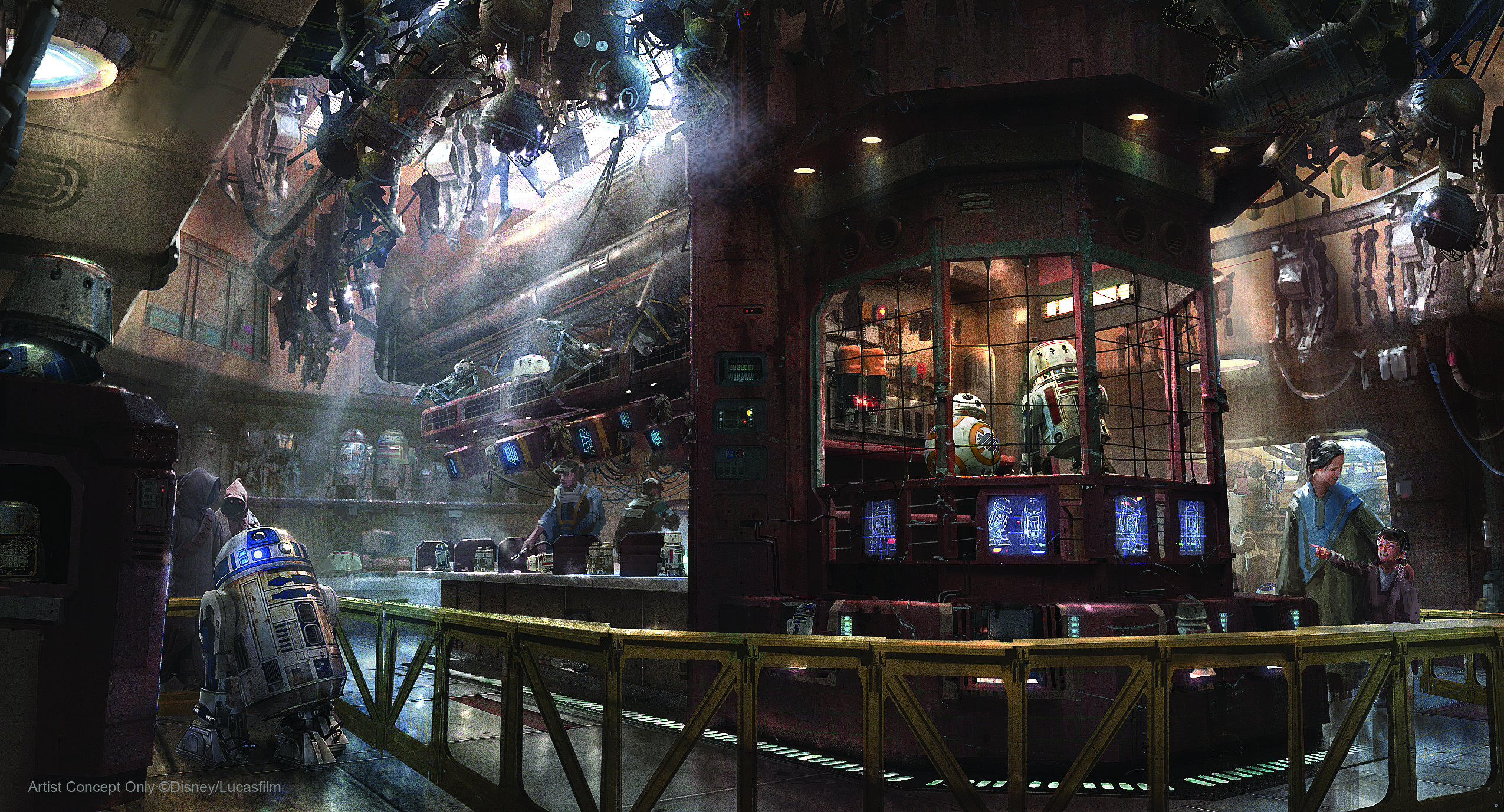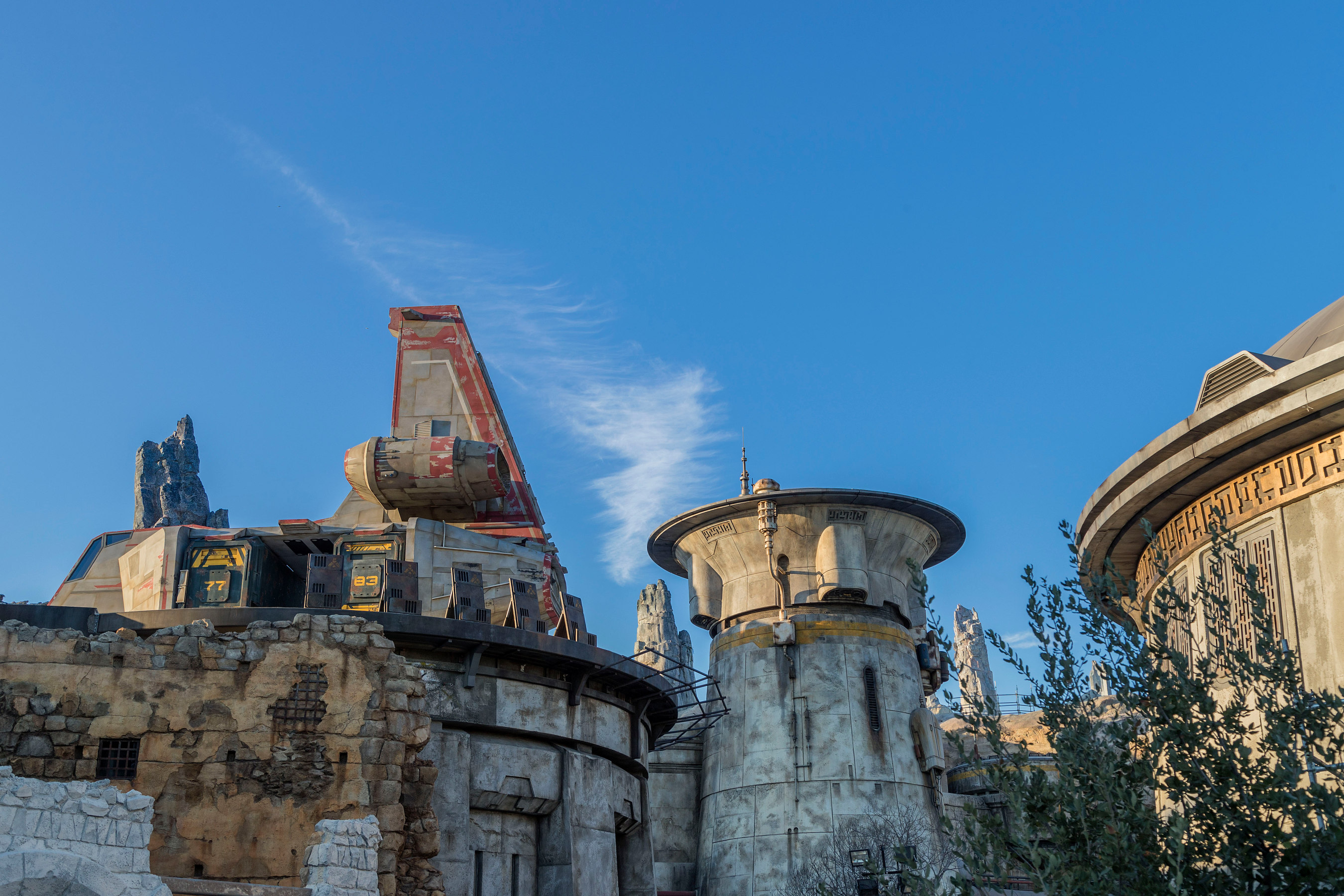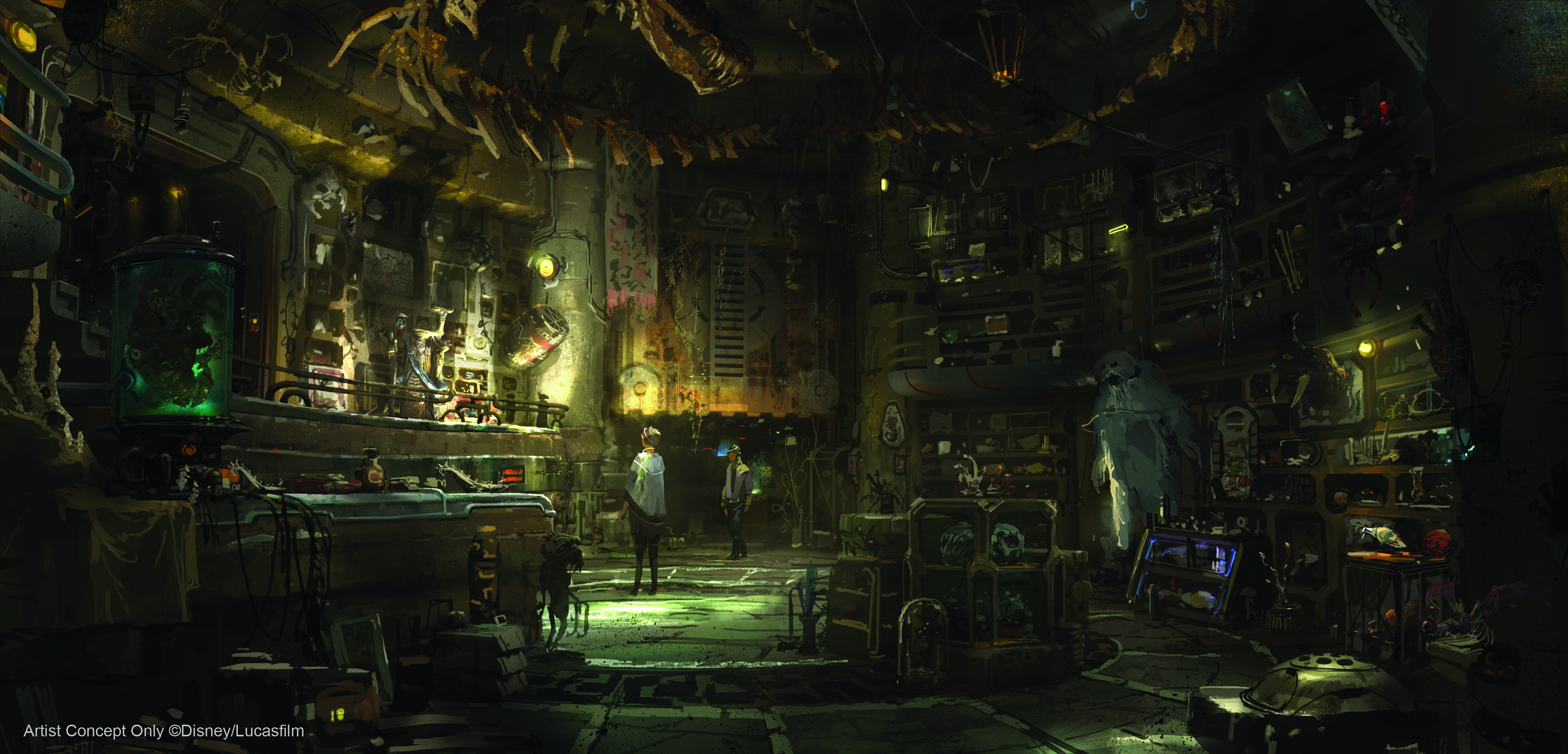How Disney Built Star Wars, in real life
From the moment that Disney announced its acquisition of Lucasfilm, the question on every fan’s mind was “when will they build Star Wars in real life?”
While most assumed that they would do it eventually, they probably weren’t aware that in 2013 even as work began on the first movie of the ‘final’ trilogy, work also commenced on the early planning of Star Wars: Galaxy’s Edge. That initial team of a handful of people would eventually grow to over 4,000.
Over the course of the past 5 years, Walt Disney Imagineering has been hard at work making the world of Star Wars a reality on Earth. In two locations, California and Florida, Black Spire outpost on the planet of Batuu is now under construction. It’s an enormous several-billion-dollar bet that people will want to visit a place very similar to the ones that they’ve seen on the screen for decades.
In some ways, this project seems like the safest bet ever. The confluence of rabid fans of Star Wars and disciples of Disney’s particular flavor of amusement park alone feels like it could fuel the demand for the two park additions for years. But the ambitions of Walt Disney Imagineering staff and Parks management are stratospherically high for what is the largest single land expansion ever in a US Disney park. And the financial results required from these additions will require Disney to draw not just the loyalist crowd, but to convince a wide and deep array of park visitors to spend the day in a hyper-faithful reconstruction of a fictional far away galaxy.
To do this, Disney’s Imagineers have spent over five years planning and two years building the outposts that will open this year in its two US parks.
Last week, I got to spend three days talking to those Imagineers, partners from Lucasfilm and management about the inspiration, planning, tools, design and construction efforts. I also visited the construction site of Star Wars Land in Disneyland, California to take in the size, scale and environment of Batuu and its two major attractions.
“We’re really being very ambitious with what we do with Star Wars,” says Disney Portfolio Executive at Walt Disney Imagineering, Scott Trowbridge. “This location is over 14 acres. It is basically a small city in our parks. All the amazing architecture…the ships, the aliens, the droids, the creatures, everything that makes Star Wars Star Wars, all coming together so that our guests can have an opportunity to live that dream of living their Star Wars story.”
At risk of being too susceptible to marketing speak, I’d have to agree with this particular statement. What is being built here has little parallel in terms of immersion and ambition in an amusement park or out. And it’s going to blow Star Wars fans, casual and involved, away.
The nuts and bolts
If you’re familiar with what Disney has said about its “Star Wars lands” so far, then some of the following might be a refresher, but I think that some context about what they’re trying to build is important before we talk about the how.
Covering 14 acres individually at both Disneyland, Anaheim and Disney’s Hollywood Studios in Florida, the lands are pieces of the planet Batuu, and they host Black Spire Outpost, a village with shops, eateries, villagers and a First Order advance post. Outside of the village, you can also find the Resistance encampment with its ad-hoc infrastructure, rag-tag starfighters and equipment. The lands house two major attractions — Star Wars: Rise of the Resistance and Millennium Falcon: Smuggler’s Run.
The entire land has been designed from the ground up to be immersive. The Disney cast members that inhabit Batuu will dress in authentic costumes and can pick and choose their own garments and accessories from a selection. They will be encouraged to have an understanding of the village, the various factions at play from the resistance to the First Order to the underbelly of smugglers operating there. The food is completely new, and it all has backstory as well. You won’t have pork ribs, you’ll have Kaadu ribs — the non-famous creature famously ridden by famously hated Jar Jar Binks. You’ll drink blue (and green) milk and cocktails at the seedy cantina (yes, with alcohol). The signage is all in-universe as much as possible, the products for sale have been created from scratch just for Batuu and will be sold nowhere else — and they all have a ‘found’ or ‘crafted’ vibe with minimal packaging.
The name of the game is transportive.
Transportation to Batuu
One of the over-arching themes throughout the discussions over the course of several days was the concept of transportation. How do you convey the feeling of being transported from the worlds of Disneyland and Earth to the world of Star Wars.
That begins with the decision to make the location for the lands a new planet.
“Why not make a place that is very familiar from the classic Star Wars films, a Tatooine, a Hoth, or one of those places? The answer really is we know those places, we know those stories that happen there, and we know that we’re not in them,” said Trowbridge. “This place, Black Spire Outpost, is an opportunity. It’s designed from the very get‑go to be a place that invites exploration and discovery, a place that invites us to become a character in the world of Star Wars, and, to the extent that we want to, to participate in the stories of Star Wars.”
One of the primary drivers for the decision was also to create some sense of equanimity between hardcore fans and casual attendees.
“I want to walk into this land and be in the same level as everyone else, from the really hardcore Star Wars fan to someone who knows nothing about Star Wars,” Managing Story Editor at WDI Margaret Kerrison recalls saying in the first pitch meeting she attended for Star Wars land. “I want to have that urgency to explore, to discover, to run around every corner, and to meet every single droid and alien in this land. I want to not feel like I’m at a disadvantage because I don’t know all the nitty‑gritty details as a hardcore Star Wars fan would know.”
Walking through one of the entrances to Batuu, guests should feel a bit of compression and then decompression, says Executive Creative Director, WDI Chris Beatty. Coming in from Frontierland, Critter Country or just outside Fantasyland, you’re presented with ‘laser cut’ rock tunnel that creates a blank slate that then opens up into a cinematically framed vista that varies depending on your entrance. For the middle tunnel, you get a peek at some of the architecture, for instance and then boom, you’re presented with ships in the foreground, buildings, tall ancient spires, ships perched atop the buildings, canopies sawing in the wind. Shot established, you’re in Black Spire Outpost.
There are several of these ‘reveal’ moments throughout the land. The first time you see the resistance encampment, your first glimpse of the Millennium Falcon. Photographic moments, but also establishing moments, grounding you in the place you’re in.
Having stood in that vantage, even with construction going on all around, I can tell you it’s incredibly effective. There is no hint or trace of the rest of the park here. The vegetation, the meticulous weathering and rockscapes and the eerily familiar yet newly remixed shapes of Star Wars buildings and accessories make you feel like this is another place that you know.
The land is constructed using a blend of familiar techniques and newly minted ones. In some ways, Disney’s Pandora – The World of Avatar at Walt Disney World and its in-theme dining, open spaces and rides feels like a test run for how far it could push themed worlds. Star Wars: Galaxy’s Edge feels like an additive result of learnings from a land that has ‘native’ merchandise and foods and tries to keep as much as possible ‘in story’.
Before they could begin to build, though, Imagineers had to build the tools to do so.
Building Star Wars
Headquartered in the compound of low beige and salmon colored buildings making up Grand Central Business Park in Glendale, California, Walt Disney Imagineering (WDI) is a wonderland of mad tinkers, costumers, roboticists, simulations engineers and historians. The only Disney design and development organization founded by Walt Disney himself as WED Enterprises (and later sold to the Disney company in a somewhat controversial move for the time). Since then, it has proven to be so influential around the world through its application of theming and robotics that the term Imagineering is synonymous with the basic concept of world building.
One of the things that you have to understand about the way that Imagineering works is that they waste as little effort as possible. The imagination is always a hundred times more creative, complex and ambitious than the reality, and to even get a tiny chunk of that in front of guests Imagineers have to constantly find ways to work within constraints of time, space, money and, yes, the laws of physics.
In order to get the job done, they often build their own tools or cobble together solutions for problems out of a combination of off-the-shelf hardware and custom built components. It feels a bit odd to describe it this way, because there is certainly pride involved, but building for Imagineering is remarkably ego free. It’s not ‘our way or no way’ it’s ‘whatever works’. This commitment to making the illusion complete for the viewer no matter what the source of the solution is has led to some really fascinating advances from Disney R&D and Imagineering.
You only have to look at the procession from a couple of metal slugs attached to a servo through to full on humanoid stunt doubles to see what the kind of teasing out of technical applications to storytelling problems happen inside Imagineering.
For the Galaxy’s Edge project, one of the first problems to be solved was how to manage such a complex undertaking inside WDI and in partnership with Lucasfilm.
This was largely due to the major difference between this project and any that Disney has undertaken in the past: the intimate involvement of all departments from the beginning. People from props, set dressing, construction, merchandising, food, ride systems and technical departments all worked together from ideation onwards. On a normal production, they are typically brought in at various phases — but for Batuu, everyone had to be on the same page from the very beginning.
If Disney wanted this to be a truly immersive experience it had to feel organically integrated and the conversation had to be lengthy and continuous so that set design served vending and vending served story and story served ride systems and engineering. They all had to be in lock step.
One of the major tools Imagineering used to keep everyone on the same project page is their BIM (building information modeling) tool. The tool takes a combination of 2D plans, 3D models, infrastructure and set dressing information and combines them into one massive interlocking source of truth for all departments to pull from. Teams were able to drill down from an overview of the land in 3D to the design plans for a specific doorway control panel.
Basically, it’s foundational geometry from across the project that’s then fed into the Unreal engine and presented in 3D. Like a 3D world from a game, but it’s a real place with real plumbing, architecture and technology underneath.
“When we saw the level of complexity that we were faced with when we started this project, we understood that we would need to use all the tools at our disposal. What the plan was is that we would essentially build a digital replica of the entire project. We built the planet before we actually built the planet,” said Sanne Worthing, Manager of BIM & VDC Technology, WDI. “It allows the creative designers to make decisions. It allows our contractors and the guys actually out in the field to make decisions before they actually have to go through and do these things. It gives you a lot of planning time. It helps avoid some of the more complicated and costly problems out in the field.”
BIM allowed the teams to do everything from testing how things would interlock in 3D to seeing where cranes could be placed during construction. The BIM reconstruction also fed into a system that WDI built in virtual reality to simulate the park.
“Using Unreal, we were able to take from all different parts of our attraction and put the moving pieces together. That means putting in our media that we would get from ILM, our partners there, getting our animation for our animated figures. Every piece of our puzzle to create our attraction, we put into a virtual reality simulation,” says April Warren, Show Programmer for WDI. “We’re able to look at it and make quick iterations with our creative team to be able to find things that we wouldn’t find normally until we were in the field and solve those problems early, or to be able to find out something just wasn’t working for us creatively and we wanted to change that.”
WDI has been using its own VR simulation system for a while, I first saw it a couple of years ago when it was being fleshed out. It feels very similar to flying around inside a simulator. It allows the Imagineers to look at the land from all sides, swooping through projects and highlighting elements of various types from infrastructure to set dressing. More importantly, it allows them to get as clear a picture as possible of what it will look like to a guest on the ground. This includes sight lines that play to maximum effect, with forced perspective and seamless presentation while hiding things like heating and cooling units, conduits and ducts and regular Earth buildings.
“We do do a lot of work with sight lines, making sure that when you’re out in the land, where guests are moving through, that the experience is what we intend it to be. That we’re not looking at some ugly AC unit,” says Worthing. “Immersion, and making sure that people feel like they are immersed in this world is super important. BIM is one of the ways that we are able to do that.”
“There’s things from the BIM that have been super [helpful],” says Warren. “We’ve had some back and forth I would say trying to run a vehicle through an area and I go, “oh, there’s a piece of conduit there that I didn’t realize what going to be there, because I got from…BIM.” I can say, “Hey, can we remove that piece of conduit?”
“If we were in the field and we had planned this without that step, we could have been in trouble because we might have hit it.”
A saying that the Imagineers have, says Bei Yang, Technology Studio Exec, WDI, is that it’s “easier to move bits than it is to move Atoms.”
There is a daily review of packages added to BIM, which allows the ride and animatronics team to ‘walk’ inside the attraction regularly before it’s built.
“While we’re only building one building, I promise there are a hundred designs of that building that nobody will ever see,” says Jacqueline King, Producer on Millennium Falcon: Smuggler’s Run. “We get to go into them, and be able to make the best decisions, so that when we start putting rebar into the ground, you’re putting it in the right place. They talk about discovering those walls once you get out in the field later, but for the most part, we’re able to work out a lot of those early on, and completely change layouts to get the best results.”
In addition to using VR simulations driven by BIM, WDI has also begun using it for simulation of the actual rides, but more on that a bit later.
Once the construction pipeline was in place, it was time to start fleshing out the physical world of Batuu, including the architecture, set dressing, props, merchandise, food and inhabitants.
Designing Galaxy’s Edge
The design of Batuu extends across all of the major food groups of a Disney Park, but this time they were all designed in concert with one another. From the architecture and props to the costumes to the music, food and merchandise. It’s all imagined Star Wars from the ground up.
Disney does not have a standing construction crew, especially not one as large as 3,000 people. So, to make sure that their design work was executed by people that care, they brought in partners and started indoctrinating them in the process and the land’s purpose. And, most importantly, they listened to them and asked them to get involved in how to execute on the vision.
“It turns out Star Wars, there’s lots of pipes,” jokes Robin Reardon, Portfolio Executive Producer at WDI. “We drew lots of pipes, we modeled lots of pipes, there’s pipes. We met with a mechanical contractor and said, “We could make these from scratch, but hey, look, you do pipes.” He was so excited because, normally, the work of a mechanical contractor is up in the ceiling or inside the walls, and maybe you see a vent. [They were excited] that their work got to be on a stage, so that when they take their family in and say, “I did that. That’s part of the world. That’s part of what’s on stage,” it’s been fun. It continues to be. His whole team continues to be really enthusiastic about what they’re doing there.”




Comments
Post a Comment